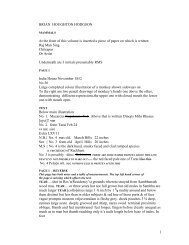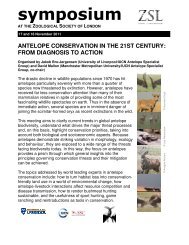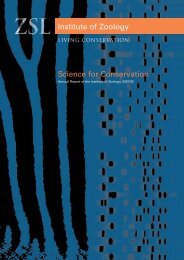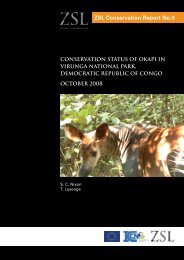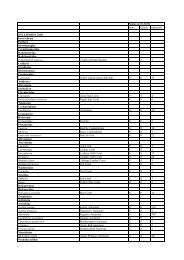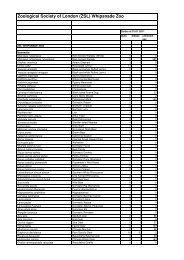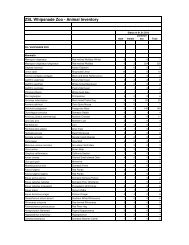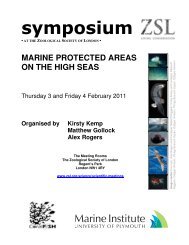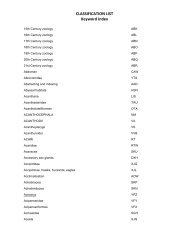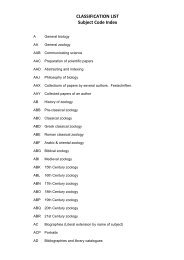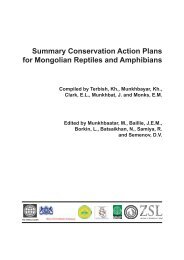Biodiversity of the Rewa Head B Zoological Society of London ...
Biodiversity of the Rewa Head B Zoological Society of London ...
Biodiversity of the Rewa Head B Zoological Society of London ...
You also want an ePaper? Increase the reach of your titles
YUMPU automatically turns print PDFs into web optimized ePapers that Google loves.
Chapter 3. Reptile Species Diversity<br />
No specific herpetological studies took place, however several observations made<br />
during drift transects or through chance encounters are worth recording.<br />
Firstly <strong>the</strong> complete absence <strong>of</strong> black caiman (Melanosuchus niger) and spectacled<br />
caiman (Caiman yacare) in <strong>the</strong> <strong>Rewa</strong> <strong>Head</strong> is interesting and is likely to be due to Corona<br />
Falls acting as a dispersal barrier. The contrastingly high numbers <strong>of</strong> Schneider’s dwarf<br />
caiman (Paleosuchus trigonatus) above <strong>the</strong> falls may be due to <strong>the</strong>ir preference for cool,<br />
fast flowing forest streams ra<strong>the</strong>r than ecological release from competition with o<strong>the</strong>r<br />
crocodilians. Magnussun et al (1987) considered <strong>the</strong>re to be resource partitioning between<br />
dwarf and spectacled caiman as a result <strong>of</strong> differing habitats and prey selectivity which<br />
precludes competition from occurring. However, Medem (1971) reported that following<br />
hunting for skins <strong>of</strong> black and spectacled caiman from rivers in Colombia, <strong>the</strong> un-hunted<br />
dwarf caiman (due to <strong>the</strong> low value <strong>of</strong> its skin) expanded its range, so perhaps competition<br />
does play a role in explaining <strong>the</strong> pattern seen. Below Corona Falls we observed both black<br />
and spectacled caiman but no dwarf caiman. The species is known to exist in <strong>the</strong> Lower<br />
<strong>Rewa</strong>, but at much lower densities (Holland unpublished data) and is rare downstream <strong>of</strong><br />
<strong>the</strong> Kwitaro mouth.<br />
Figure 33. Schneider’s dwarf caiman (Paleosuchus trigonatus) in typical head-up resting pose.<br />
With regards to Testudines, most conspicuous in its absence was <strong>the</strong> giant Amazonian<br />
Turtle (Podocnemis expansa), classified as ‘Lower risk/conservation dependent’ and<br />
yellow-spotted sidenecked turtle (Podocnemis unifilis), classified as ‘Vulnerable’, both<br />
<strong>of</strong> which were recorded in <strong>the</strong> Lower <strong>Rewa</strong> up to Corona Falls, yet as with <strong>the</strong> spectacled<br />
and black caiman, absent from <strong>the</strong> <strong>Rewa</strong> <strong>Head</strong>. Ano<strong>the</strong>r Testudine <strong>of</strong> particular note<br />
encountered on a hill in dense forest in <strong>the</strong> <strong>Rewa</strong> <strong>Head</strong> was <strong>the</strong> yellow-footed tortoise<br />
(Geochelone denticulata) described as ‘Vulnerable’ in IUCN Red List reports.<br />
We encountered 6 green anacondas (Eunectes murinus) in <strong>the</strong> <strong>Rewa</strong> <strong>Head</strong> during <strong>the</strong><br />
expedition. Five <strong>of</strong> <strong>the</strong>m were basking on <strong>the</strong> river bank while <strong>the</strong> sixth was actively<br />
swimming. In order to ascertain our size estimates were correct, we captured a large<br />
anaconda and measured it, taking three measurements from nose tip to tail tip using a<br />
length <strong>of</strong> string and assumed <strong>the</strong> mean measurement to be accurate. Our estimated length<br />
<strong>of</strong> 17ft proved close, but short by 1’2”. The snake’s total length was 18’2”. Unfortunately no<br />
weight was taken, but <strong>the</strong> animal’s girth at its thickest point was 27”. The o<strong>the</strong>r anacondas<br />
seen were estimated as 8ft, 15ft, 16ft and two at 17ft. The presence <strong>of</strong> <strong>the</strong>se very large<br />
snakes in <strong>the</strong> area is extremely interesting as in <strong>the</strong> longest-running study on anacondas in<br />
<strong>the</strong> world, in <strong>the</strong> Venezuelan Llanos, Jesus Rivas captured over 900 animals yet recorded<br />
few specimens growing larger than 16’ long. There is undoubtedly a good prey base for<br />
<strong>the</strong> anacondas in <strong>the</strong> <strong>Rewa</strong> <strong>Head</strong>, with capybara and dwarf caiman plentiful.<br />
24 <strong>Biodiversity</strong> <strong>of</strong> <strong>the</strong> <strong>Rewa</strong> <strong>Head</strong>



